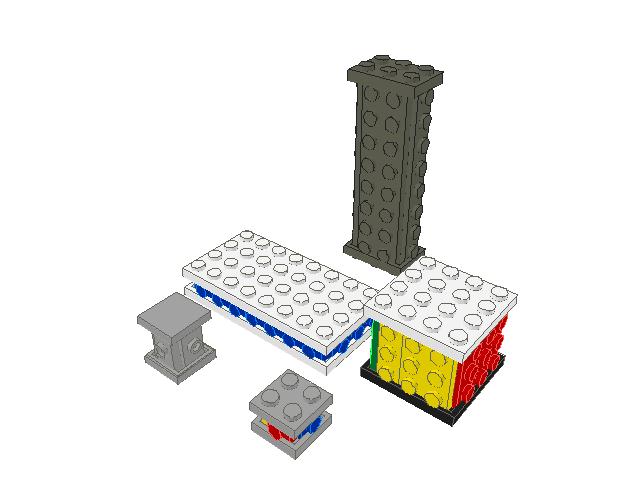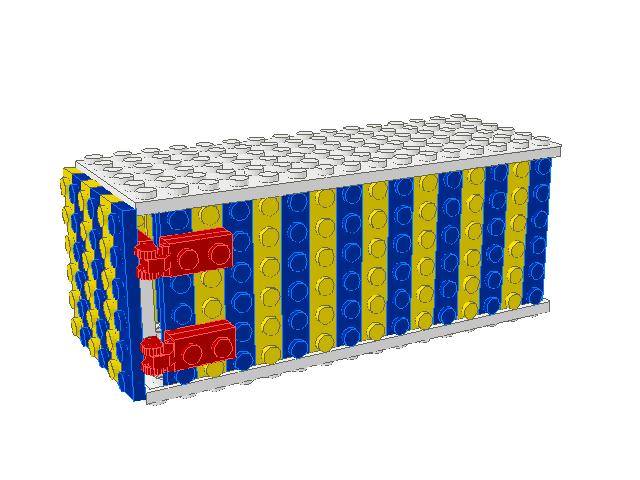| |
| |
I discovered this fitting during some sorting. The plates had gotten ‘jammed’
together.
Works especially well if you create a ‘box’ from four plates. Tiles work well
too.
And I believe if you use a 3wide plate between your other two plates, it’s a
whole number brick height. Can’t confirm it now, bricks are still packed from
the move.
Aaron
|
Yes, you are right. Sort of; it should be a 2wide plate (or a 2 + (2 * n) wide).
This insight of yours and your reply to this (by now quite old) post got me
thinking again about what this technique actually could be good for. The result
was this proof of concept MOC of a bus stop:

It’s virtual: not because I didn’t have the pieces to build it, but because I
don’t have a digital camera here right now.
Your technique is used in the brown bench to the right.
Note in the shelter and the waste basket how inverse pony ear works together
with normal pony ear by creating four-sided inverted pony ear boxes that can
then be given a roof and fastened onto the ground by normal pony ear. If, on the
contrary, you ponyear (Am I the first one to use that as a verb?) together four
plates in a square four-wall pattern and then try to ponyear a fifth and sixth
top or bottom side onto them to make a cube it will not work as the geometries
don’t add upp.
By the way when I think about it “Inverse Pony Ear” sounds less cryptic that
“RaeYnop,” if I get to name this technique.
/Martin
|
|
| |
In lugnet.build.schleim, Martin Nilsson wrote:
| |
| |
I discovered this fitting during some sorting. The plates had gotten
‘jammed’ together.
Works especially well if you create a ‘box’ from four plates. Tiles work
well too.
And I believe if you use a 3wide plate between your other two plates, it’s a
whole number brick height. Can’t confirm it now, bricks are still packed
from the move.
Aaron
|
Yes, you are right. Sort of; it should be a 2wide plate (or a 2 + (2 * n)
wide).
This insight of yours and your reply to this (by now quite old) post got me
thinking again about what this technique actually could be good for. The
result was this proof of concept MOC of a bus stop:

It’s virtual: not because I didn’t have the pieces to build it, but because I
don’t have a digital camera here right now.
Your technique is used in the brown bench to the right.
Note in the shelter and the waste basket how inverse pony ear works together
with normal pony ear by creating four-sided inverted pony ear boxes that can
then be given a roof and fastened onto the ground by normal pony ear. If, on
the contrary, you ponyear (Am I the first one to use that as a verb?)
together four plates in a square four-wall pattern and then try to ponyear a
fifth and sixth top or bottom side onto them to make a cube it will not work
as the geometries don’t add upp.
By the way when I think about it “Inverse Pony Ear” sounds less cryptic that
“RaeYnop,” if I get to name this technique.
/Martin
|
“Twixt Wall And Tube”?
Neat technique! Your MOC does a good job of demonstrating how this might
actually be useful.
Marc Nelson Jr.

|
|
| |
| |
Note in the shelter and the waste basket how inverse pony ear works together
with normal pony ear by creating four-sided inverted pony ear boxes that can
then be given a roof and fastened onto the ground by normal pony ear. If, on
the contrary, you ponyear (Am I the first one to use that as a verb?)
together four plates in a square four-wall pattern and then try to ponyear a
fifth and sixth top or bottom side onto them to make a cube it will not work
as the geometries don’t add upp.
|
OK, I realize now that what I said in the above paragraph is not technically
correct. You can create cubes with pony-ear technique too, sort of, if you leave
some space here and there (actually like I’ve done in the shelter which is half
pony ear, half inverse pony ear). But I also realize that what I should have
been talking about was this:

This has to be good for something. If nothing else it is yet another way of
creating stable 180 and 90 degree connections.
Or maybe one could use it as a way to make a lot of cheap containers for some
big train layout:


/Martin
|
|
|